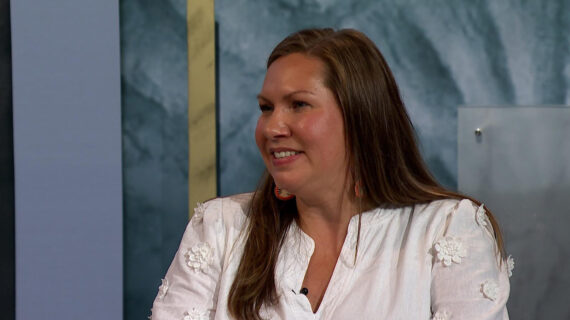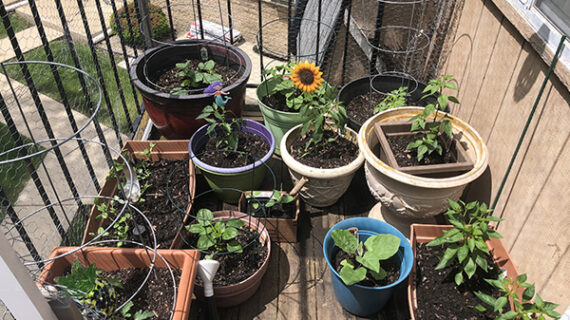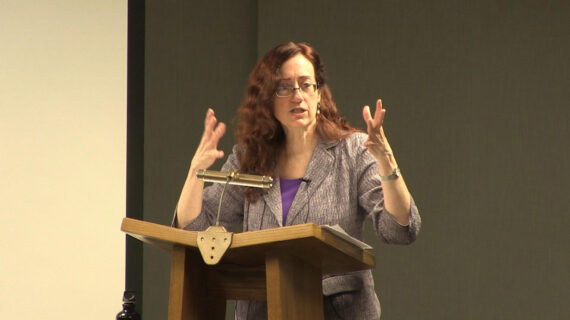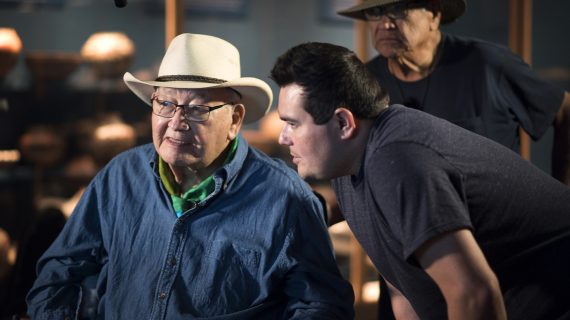Today, we are pleased to introduce Marcus Cederstrom as part of the Wisconsin Historical Museum’s History Sandwiched In lecture series. The opinions expressed today are those of the presenter and are not necessarily those of the Wisconsin Historical Society or the museum’s employees. Marcus Cederstrom is the community curator of Nordic American Folklore in the department German, Nordic, and Slavic at the University of Wisconsin, Madison. He holds a PhD in Scandinavian studies. As a folklorist, his research focuses on Scandinavian immigration to the United States, identity formation, North American indigenous communities, and sustainability. Here today, to discuss what life was like for Swedish working women in the early 1900s, please join me in welcoming Marcus Cederstrom. (loud clapping)
– All right, thank you so much for having me. I’m glad we got that out of the way, that these are my opinions. (laughing) So I’m going to be presenting a little bit on single Swedish working women mostly in the upper Midwest. We’ll kind of touch on a few other places and mostly in actually urban settings instead of the farm. So when we talk about Scandinavian America or we talk about Nordic America, a lot of times we talk about the upper Midwest. Millions of people came here from Finland, from Norway, from Sweden, from Denmark, from Iceland, from the Faroe Islands, from Stokke and settled here. So I’m going to actually make you guys do some work, right off the bat. I just kind of want to hear what do you guys think? What do you think of when you think of Nordic America? You can just yell it out.
– [Audience Member] Lutefisk.
– Lutefisk, beautiful, absolutely.
– [Audience Member] Lefse.
– Lefse, all right.
– [Audience Member] Smorgasbord.
– Smorgasbord, you guys need to come next Tuesday, apparently, for the talk on for the talk on food ways. What else we got? – [Audience Member] Heart on your fiddle.
– Heart on your fiddle, beautiful, absolutely.
– [Audience Member] Rosemaling. – Rosemaling, fantastic.
– (mumbling) – What was that?
– [Audience] I said, “Oh yeah!”
– Oh yeah, absolutely, right? So we’ve got art, we’ve got food. We’ve got a lot of other things. We’ve got rag rugs, of course, Finnish rag rugs. We’ve got wood carving. We’ve got baking as an art form. We have church identities. No one tossed out the word Lutheran, which actually surprised me a little bit. (laughing) We have farming, right? We also have political identities. And we’re going to talk about that towards the end here. But Swedish America’s a lot of things. Nordic America is a lot of things. It’s all the things you listed, but it’s not just that. And I’m going to talk a little bit about what the program, what the title promised, Swedish working women here in the United States during the height of immigration. So between 1850 and 1930, about one, 1.25 million Swedes came to this country. Of those, almost a quarter million were single women. So that’s 20% of immigration to this country of Swedes were single women. They were not just men. They were not just families. And they were not just farmers, that were coming to this country.
So that means that you end up with a lot of Swedish American communities, 1.25 million people. And when a quarter of a million of them are single, they kind of flock to places where they feel comfortable, where they can create a community of like-minded, or at least like-speaking individuals. By 1910, first generation and second-generation Swedes made up about 18% of Minneapolis’s population. What’s impressive is that by 1920, that number had dropped to 17.3. That suggested a lot of Swedes were still coming. A lot of Swedes were still coming to Minneapolis, settling there, and that a lot of Swedes were marrying other Swedes and having other Swedish American children. So here, you’ve got a little store. And I love this. I’m supposed to stay stationary here, but if you see in the corner there, (foreign language). Scandinavian newspapers are for sale at Samuelson’s Confectionary. And we’ve got it in Swedish. We’re living our lives in the United States, but we’re living our lives in Swedish, and Danish, and Norwegian, for generations. So why did they come then? Why did all these 1.25 million people, why did these 250,000 single women come? Life as an immigrant is hard. Life as an immigrant now is hard, life as an immigrant then was hard. And I promised in the little description of this talk, that we’d be using the words of the Swedish women who came. Of course, we don’t have these recorded, at least not so we can listen to them. But we do have their letters, we do have their diaries. We do have their poems, their essays, their newspaper articles, almost all of them written in Swedish. And so some of these women, they came ’cause they were in search of adventure. They maybe didn’t plan to stay, but Anna Olson wrote about her personal immigration story to the Nordic Museum in Stockholm back in the 1960s. She married, and eventually settled in the Bronx.
She wanted to see more of the world. Others came to the United States with no plans to stay, whatsoever. The US offered economic benefits, or at least the appearance of economic benefits. And so women like C.A. Olson here, she came. She came to the US. She didn’t return to Sweden though. She had no plans: “I was 15 years old when I left Sweden with confidence that I would improve my economic position so that one day I could earn enough money to return to Sweden and buy a little home for my mother and sister and in that way improve life for all of us.” She settled in Superior. There are a bunch of Scandinavians, a bunch of Nordic people, Finns especially, who settled in Superior, Wisconsin. Still others, they left because everyone else was leaving. Ida Pettersson, Ida Pettersson here, she spent four years in Chicago before returning to Sweden. But she left because of America fever. All of her friends, all of her classmates, they were all leaving. It’s hard to stick around in a small town when what you see is all of your friends and all of your classmates and everyone your age leave. And so she went. So this is Swede Hollow. Swede Hollow is in Saint Paul. Swede Hollow is now a park. It used to be “the place” that Swedish people settled.
They moved there and eventually, they moved out. Italian immigrants, Irish immigrants, Mexican immigrants, they moved in afterwards. The Swedes from Saint Paul and Swede Hollow moved to Minneapolis, eventually. But once in the US, many of these Swedish women who came, they found work in domestic service. In 1910, the Dillingham Commission put together a report. And 76% of Swedish-born immigrant women and 50.8%, I’ve got the numbers written down here, of American-born Swedish immigrant women worked in domestic and personal service jobs. The last part here is what’s important. They were the bread winners for their households. 76% of Swedish immigrant women worked in domestic service and were the bread winners for their household. They lived in places like Swede Hollow. They lived in places like Minneapolis. And they’d go to work. They’d come home every night. Or, they’d live in the homes of the people that they worked for. They’d get maybe Thursday afternoon off. They’d get maybe Sunday off, and that was that. They spent the rest of their time serving the family that they worked for. Finding work depended a lot on who came before you. So this is a term that’s been used in a little bit more of a partisan way recently. But scholars often talk about chain migration. We talk about chain migration in this broader sense. So community members left their home towns. They moved to Minneapolis. They moved to Superior, they moved to Madison. They’d work here. They’d earn enough money, they’d buy a prepaid ticket, and they’d send home for their friends, for their sisters, for their brothers, for their family, who would then come and settle in the exact same community. This went on from community to community. You’ve got some communities that essentially moved wholesale from Scandinavia, from Sweden to somewhere in the upper Midwest. This also happened with labor. People would find other people a job. Maybe you wanted a job sewing, and so you got a job at the Northwestern Knitting Company, which produced Munsingwear. They were the largest employer of women in Minneapolis. So in 1914, 200 men and 1500 women worked there.
By 1918, the company employed 3,000 people. So we’re growing pretty quickly here. Of those 3,000, 2,500 were women and 400 of them had been born in Sweden, or to Swedish parents. What this did, is it again, created a sort of community, created a community of Swedish speakers, created a community of women who were working, who oftentimes were single, who were living together, who were earning enough money to do whatever it is they wanted to do. Sometimes that was take care of a family that they had. Sometimes it meant sending money home. Sometimes it meant just earning enough money to go on that adventure, to see the world, like they wanted to. Other people didn’t necessarily work in a place like this. They worked in private homes, individual homes, for wealthier families. And their engaging with this broader community could be difficult. Being able to talk to Swedes when you’re one of maybe a handful of people employed, becomes a lot harder. And that’s where those Thursday nights off become important. That’s where those Sundays off become important. That’s why community dances were so important. That’s why the church was so important. They created a place of community. Joy Lintelman, she’s a historian, she writes in her book, “I Go To America: Swedish American Women, the Life of Mina Anderson,” that most Swedish women improved their situation, they improved their lives by migrating to the United States. They found higher wages. They found better accommodations. They found more time off, less physical labor, and they could pretty easily change jobs. Sounds pretty solid. According to Lintelman then, and I’m quoting here, “Most single Swedish immigrant women found things better as a result of their immigration to the United States.”
And they found it comparatively easier than from male migrants from Sweden. So while things may have been better, that does not necessarily mean that they were good, nor does it mean that immigration to the United States was a ticket to the middle class. So many of the issues that were being grappled with simultaneously in Sweden, were things that they were grappling with here, in the US. As early as 1873, the Swedish Language Press, and there was a ton of newspapers that were being printed in Swedish, and in Danish, and in Finnish, and if you were here last week, they were talking about German language newspapers. So while this discussion was going on, the newspapers were also engaging in this debate, questioning is it better to be a maid in the US or is it better to be a maid in Sweden? And two rival newspapers in Chicago were going back and forth. This is one of those things that’s sort of exciting and sort of super nerdy. But they were loving it. They were going at it. And they were discussing working conditions. They were discussing pay, they were discussing all of these things that make a life for a worker.
They never really solved the debate. One of the newspapers though did claim, (foreign language) , the New World, claimed that working conditions were better in the US. And if anyone was going to immigrate to the US, if anyone was going to emigrate from Sweden, it should be domestic servants. Of course, as we see here in this cartoon, and I don’t know if you can totally see the translation there. It’s a cartoon that showed up in a Swedish speaking newspaper. And in it, it’s a maid who is interviewing for a new position. And the head of the household, the man of the household, asks why did you leave your last position? And she responds, “Well, it was, was, it was because I let the man of the house kiss me.” And the man says, “Wait, what? What’s that? You… The job is yours.” (laughing) So what we see again, better doesn’t necessarily mean good. Low pay, long hours, poor working conditions that sometimes involved sexual harassment were par for the course, unfortunately. Things like this were not always talked about openly. So we get it in cartoons. It’s hard to study sexual harassment in 1910 in Minneapolis. But we get newspaper articles, we get letters, we get those cartoons. We get jokes that still remain today. I’m going to read this one, ’cause I have to admit, despite my job title, I don’t know any Ole and Lena jokes. (laughing)
I know, but this one speaks a little bit to these difficult working conditions for women. And it says here, “Lena asks Mrs. Johnson, the head of the household, for some time off because Lena’s boyfriend, Ole, is coming to town on furlough. Mrs. Johnson asks, how long is Ole’s furlough? And Lena responds, yust as long as Mr. Yohnson’s, but not so quite tic.” So here we have Lena portrayed as a promiscuous maid.
– (laughing)
– Right? She’s clearly familiar with the intimate details for Mr. Johnson’s anatomy. (laughing) But the joke suggested the Scandinavians are aware of what’s going on. It suggests that they know the power dynamics that are happening in the home. They know that these women, these single Swedish women, are having to deal with this, with sexual harassment, with sexual assault and that sometimes it results in maids sleeping with their employers. And so regardless of which side of the Atlantic was better, women still came.
Evelina Mansson, for example, she came twice. She immigrated, found some success in the US, earned enough money to actually bring her sister over and then to actually move back to Sweden. And she did. She moved back, she stayed there for a couple of years and then she came back to the United States again. And then she stayed for good. Excuse me, and then she returned to Sweden, where she stayed for good. Back and forth twice, but in her six years in the United States, she held at least eight different jobs, her ticket was paid for by a family member. And she notes in her biography, her memoir, that you begin your life in America burdened with debt, something that is of course, very common. So she played her own role in helping people begin their life burdened in debt in the United States by sending a ticket to her sister. She got her sister a job as a janitor at the same company that she was working for. And, her sister came over then, with that debt to pay. It wasn’t just the money though. Sometimes it was just the actual conditions, the work. So Carin Nordstrom, Carin Nordstrom’s sister, she worked as a domestic servant in Chicago at the age of 17 in 1903. We don’t know her name. There’s one letter of hers in the archive in Stockholm. And it is accompanied by a letter from her sister, who sent it in, who donated it to the archive. And all we know, is that this is Carin Nordstrom’s sister. She died in 1905, at the age of 19 in Chicago. And her sister claims that she died of homesickness. The letter, like I said, it doesn’t mention her name. She signs it, “You’re loving daughter.” But she writes about the hardships in the New World. She writes of how she longs to come home. She writes that she understands that when she does come home, things will be different. That parents will have died, the people will have grown up, that other people will have left the community.
And she writes how difficult life is. She writes about the pain she feels working. She writes about the late hour, how she has to be up soon. And Carin Nordstrom, in her letter, she writes that their family was just too poor to bring her back. They recognized her pain, they recognized the difficulties, but they did not have the money to pay for a ticket to bring her back to Sweden. And so she died in Chicago. And that homesickness can be really scary. We talk about America fever and on the other end, you get the homesickness. We’re talking about physical ailments that come with this. And for some women, writing became a tool to combat that homesickness. It became a tool to seek support in a new country. So reading really connected women to a broader community through the newspapers, through the letters that they sent, and through the letters they received, through the libraries that provided free access, and sometimes study groups and lectures to immigrant groups. There’s was library up on Franklin Avenue up in Minneapolis, that had the largest collection of Swedish language literature in the United States for a while. But letters, letters became a way to seek solace in friends and family, a way to keep those connections, despite the physical distance that separated them from their friends and family. They became places to question their decisions, to lament those working conditions that we saw, to complain about the homesickness. They became simply a drawn-out conversation over time and over space, and over the Atlantic. Anna Johnson’s letter here, she wrote to a newspaper, describes a terrible illness that strikes her family. This is an immigrant experience that is very much hers. But it’s also an immigrant experience that many women in many families could relate to. Death could take away your loved ones. Immigration could mean isolation. And so for Anna and many other women, these newspapers, these letters, they provided an escape and a way to kind of connect with a larger community.
She’s writing to a group of strangers, really. But this is super intimate. And I don’t think they seem like strangers to her. The way she talks about the newspaper giving her strength and giving her a place to understand and kind of work through her life as an immigrant. All right, that was a pretty bleak picture wasn’t it? It’s rough. For a lot of people, that was reality. For a lot of people, it wasn’t, right? Of course. Some people came over and found success immediately. Those stories are actually a little more rare. Oftentimes, they’re the stories we hear. They fit into kind of our American mythos of the American dream. These stories are probably a little more common than we care to admit, and probably a little more common than we actually see. I am pretty convinced that women who were coming over were a little more honest in their letters than the men were. They felt a little more comfortable being truthful about the difficulties. Men had some sort of bravado, some sort of, you got to save face. And I think women were a little more honest in their letters, which I think is really important because it helps us understand better, the immigrant experience. So I want to introduce you now to one specific woman, Signe Aurelle, who had a similar experience. She though, decided to, and here it’s probably good that we throw in this disclaimer. She decided to join the Industrial Workers of the World, she joined the labor movement, and was a radical activist for years. So Signe Aurelle, was born February 14th, 1889 in Gryt, Sweden. She was baptized about a month later. If you’re ever doing genealogical work, church records folks, church records. Sweden keeps them all. They’re amazing. If that church didn’t burn down, they’re there somewhere. And they’re a great resource. They can tell you a lot of what life was like in Sweden, at the time.
So she was living down South there. You can kind of, sort of, see the area where she was coming from. You get a lot of people coming from Smaland, from Skane, who then came over and settled in the Upper Midwest. She lived most of her childhood in this building. This was the old schoolhouse, known as the Vastra Olinge Schoolhouse. Her father was a school teacher, and she stayed with him for quite some time before moving to the United States. This picture was taken a few years ago, but the building itself is essentially in the same form. While in Sweden, she joined the IOGT. The labor movement, the temperance movement, were super tied together. Labor fought to keep people sober, under the assumption that alcohol was really, actively harming the working class, and that the ruling class used drink, used alcohol, to kind of control their workers. You see this connection here in the United States as well. You see it very, very, very strongly in Sweden. So this is one of the first instances we have of Signe Aurelle becoming socially active. So born 1889, on April 19, 1913. She registered as an immigrant in Gryt Parrish, in her home parish. She had to register to leave. She was old enough that she did not need permission from her father to leave. But many women still needed to seek that permission. Six days later, she had to register with the police in Malmo before she traveled to Copenhagen. Once there, she then traveled from Copenhagen Denmark to Liverpool. And once there, she boarded the SS Franconia to Boston. And that was on April 29th. And a few days later, on May 7th, she arrived in Boston Massachusetts.
So this ship here, a sort of interesting fact. In the midst of World War I, in 1916, the SS Franconia was actually torpedoed. It was turned into a troopship in 1915, torpedoed on October 4th, 1916. There were 324 people on board and only 12, still 12 were killed. So it took her about three weeks, it took her about three weeks to get from her home in rural Sweden to Boston. I think it’s really important to point out, because a lot of times we think, oh these were long trips and they were long trips, especially compared to what they are today. But once we got steamships, we were making that trip pretty quickly. If you had the time and you had the money, you could go back and forth and many people did. So Signe Aurelle went first to Duluth, or at least that’s what her ticket says. I have to be honest, I have no idea what she did in Duluth. I haven’t found a single trace of her existence in Duluth, Minnesota. But by December of that same year, she’s in Minneapolis. She had at least 12 addresses while living in Minneapolis in seven years. That’s a ton of addresses. It’s August 14th, right? We’re going to see so many people in this city moving today. And I’ve done a fair share of moving myself in this city. I don’t have 12 addresses in seven years. And it really speaks to the unstable living conditions that many immigrant working class people had to deal with. Minneapolis is where she made her mark. Her first year was a rough one. She spent her first Christmas in the United States in the hospital. We know that because she continued her membership in the IOGT, the temperance organization.
And they essentially acted as a mutual benefit society. They brought her flowers, they raised money for her, they visited her in the hospital. It became a way for her to become a part of a community, almost immediately, when she got back. She was pretty active for a couple of years. She became active the next year actually, in the committee that went to visit people who are sick. I see that as kind of a nice way of paying things forward, or paying it back, I suppose. But over time, her activity in the IOGT and the temperance movement waned, and she really focused on the labor movement. So in 1915, she published her first poem in a newspaper, called Allarm, alarm. And you see there (foreign language) . Class warfare, direct action, and solidarity. I think we understand what this paper is all about. Her first poem was published in the issue in which they were honoring Joe Hill, after his execution in Salt Lake City. Kind of an auspicious way for a labor activist to make her debut, in the pages of a Swedish language IWW newspaper. His image is dominating that fold. This is what people are going to see. This is what people are going to kind of be drawn to, and then be met by her poem, as well as actually a translation of Joe Hill’s last will, which is just below the fold. She was super involved in the labor movement. She continued to write for years, both here in the United States and in Sweden. She agitated for women, especially domestic servants, arguing that they should unionize. She compared domestic service to selling your body.
This was a sort of common theme that we see appear again and again. But she really hammered it home specifically for Swedish speaking women. She was writing in Swedish. She was reaching out to a very specific audience. She also did her own fair share of agitating through direct action. A labor activist friend, Walfrid Engdahl, remembered years later what she was like. And this is translated from the Swedish here. But, he wrote, “It’s said that after one particularly well-executed washing and ironing, she got into a dispute with her rich employer about what she should be paid for her work. Because she was denied a fair wage, she took the ironed clothes and threw them in the bathtubs full of water, told the woman of the house to do the work herself, and despite being asked to come back, she never again went to work there.”
She didn’t put up with much, that she didn’t want to put up with. And this is really important again, because it fits into what we were talking about when women are the breadwinners. She, and so many other Swedish women who came, were really kind of flipping the assumption that a woman’s place was in the home. And while she did work in someone’s home, she was going to make sure that she had control over what that work looked like. So she was here for about seven years. And in 1920, she returned home. She returned home on the SS Drottningholm. This one was not torpedoed, which is good for everyone involved. And this was kind of bittersweet. So she writes in a letter to a friend, that was actually later published in a newspaper, about her conflicting emotions. She writes that she’s super excited. She loves that she’s home, that she can see her family. Her mom’s gotten a little grayer, she writes. But the sunflowers are growing almost up to the roof of the house, and she’s very excited. She says that when she comes in on the ship to port she went up and stood on deck. And she just looked out, and she couldn’t believe that the water could be that blue. She goes on then to say, “That believe it or not, I’m sad too. I don’t know what it is I’m looking for. I don’t know what it is I’m missing.”
I think this is something a lot of people who immigrate and emigrate can relate to, this feeling of where is home, where do I belong? And I don’t know why she left. In 1918, Minnesota had passed the Alien Registration Act, which required all immigrants to register. They had to register their whereabouts, and they had to declare their holdings. On that form, she responded to a question, “If you have never taken out first papers of naturalization, why have you not done so?” And she wrote in English, “I intend to return to Sweden.” And two years later, she did. It could have been because a lot of her friends had been imprisoned. She had several friends who were sent to Leavenworth, convicted under the 1917 Espionage Act. During the 1918 trial of the US vs. William Haywood. These IWW folks, these wobblies, they were sent to Leavenworth, after being convicted. Most of them had their sentences commuted. But that didn’t change the fact that they spent years of their life in prison. It didn’t change the fact that it broke up these communities, these families, these friendships. Some of it could have been because she started to see the changes in Sweden that she wanted to see here. Nearly 20% of Swedes returned home after immigrating to the United States. Again, that’s a pretty solid number. And we see this across a lot of different ethnicities. Italians, huge percentages left, Norwegians, Danes, Finns, they went back. They came to the United States as labor migrants, they came to work and earn some money. But they didn’t always stay. So they headed home. Sometimes it was because of just homesickness, right? They needed to get away. Sometimes it was because of an economic downturn in the United States. You see these recessions and you see immigration drop and emigration rise.
Sometimes it’s politics. Sometimes it’s religion. Sometimes it’s war. And they head home, so Signe Arelle, when she got home, this man, who has a fantastic mustache, is Hjalmar Branting, he was the first social democrat to be appointed prime minister of Sweden. This is a huge deal. In 1909, there was a general strike in Sweden that was crushed. Many workers were blacklisted and came to the United States. 11 years later, we have a social democrat in power, who is turning Sweden into the social welfare state that it is still today. When she returned, she continued writing for a few years. She wrote for labor newspapers in Sweden and in the United States, publishing mostly poetry. She wrote a song book with her brother, who’s a musician. But, for the most part, she moved here. She lived here. This is where her parents lived. She took care of her parents for the rest of their lives. This picture here, so the third person, it’s not great. This is her mother, Anna. And then, this is Signe Aurelle, sitting down there. And she stayed here until the very end, really, when she moved to a nursing home in a community not too far away. And moved in, with her brother, actually, in the same nursing home. She died in 1975. She was buried next to her brother, in this church. The headstone no longer exists. In Sweden, if you do not keep the– If you don’t pay, if you don’t pay for the upkeep of the grave, they remove it. And so with no family really to speak of, no children, she’s got– I’ve tracked down a nephew, a grand nephew, excuse me. But for the most part, not much family to speak of. And so her gravestone no longer can be found there.
So why does any of this matter, right? So what? So what? Why are we talking about this one woman in the context of a much bigger picture? We’re talking about her for a variety of reasons. One, because we see these experiences and how they can give us a much better picture of what immigration was like then. And, and this is very much my opinion, but I will fight for it. We see these similarities still today. Very much so. It is sometimes painful to read the letters from 120 years ago and then to read the newspaper today and see the exact same issues being discussed. But this is the world we live in, where immigrants come to a variety of different countries, looking for a better life. And sometimes they find it and sometimes they don’t. And sometimes they leave and sometimes they stay. And they might find a better life, but that does not mean it is a good life. And it means that a lot of them will fight to make that a better life. That’s I think, a really important thing to remember. There’s a bunch of different anniversaries that have been kind of coming and going in the last few years. Joe Hill was executed in 1915, so there’s a big anniversary there. The first Swedish prime minister, as a social democrat is coming up. Signe Aurelle, a hundred years before, in 1913, so 2013 she moved. So I’m working with a couple different people. One, a folk musician, actually to take some of Signe Aurelle’s songs, or poems, to turn them into songs. Many IWW poems were sung. There’s a scholar, Bucky Halker, out of Chicago. He’s a musician, folklorist, fantastic person. He talks about song poems, that these poems, they weren’t just meant to be read aloud, but they were meant to be sung. And so I’m going to play this as kind of a way to finish up here. (soft music in foreign language) (soft music in foreign language) So that was Maja Heurling, who’s actually here in April performing a few songs at a symposium we organized at the University of Wisconsin-Madison. It’s a rough song. It’s a rough song. She’s speaking to her son. Excuse me, the narrator is speaking to her son about the difficulties of life, the difficulties of immigration, the difficulties of working. But it’s a really beautiful rendition of a poem, that was first published in a newspaper. So I think, with that, I’m going to go ahead and call it good there. And thank you guys for putting up with me.
(loud clapping)
Search University Place Episodes
Related Stories from PBS Wisconsin's Blog

Donate to sign up. Activate and sign in to Passport. It's that easy to help PBS Wisconsin serve your community through media that educates, inspires, and entertains.
Make your membership gift today
Only for new users: Activate Passport using your code or email address
Already a member?
Look up my account
Need some help? Go to FAQ or visit PBS Passport Help
Need help accessing PBS Wisconsin anywhere?

Online Access | Platform & Device Access | Cable or Satellite Access | Over-The-Air Access
Visit Access Guide
Need help accessing PBS Wisconsin anywhere?

Visit Our
Live TV Access Guide
Online AccessPlatform & Device Access
Cable or Satellite Access
Over-The-Air Access
Visit Access Guide
 Passport
Passport


















Follow Us